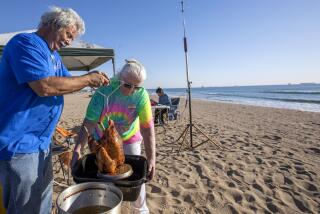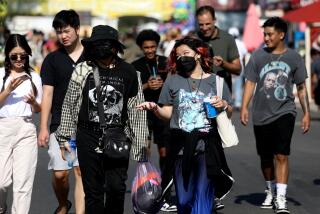As holidays approach, California unveils new rules on family gatherings, social events

With the holiday season approaching, California last week released new guidelines for socializing that prohibit gatherings among more than three households.
While coronavirus cases are dipping — and hospitalizations and deaths are at their lowest levels in months — officials are emphasizing the importance of maintaining health safety measures.
“We are entering into the holidays, but also we’re entering into the part of the year when things cool down and people are more likely to congregate ... in settings that put their physical proximity and likelihood of transmitting disease at higher risk,” Gov. Gavin Newsom said Monday.
“Don’t be misled that this disease is any less deadly. Quite the contrary — it is as deadly as it’s ever been in the context of those that are high risk.”
Newsom has warned about the upcoming flu season, which could create added challenges in battling the coronavirus, as well as the arrival of colder weather that may prompt people to spend more time indoors.
To protect public health and slow the rate of transmission, the state had previously banned all gatherings of any kind as well as any mingling of households.
Here are the latest guidelines:
1. Attendance
- Gatherings that include more than three households are prohibited. This includes everyone present, including hosts and guests. Remember, the smaller the number of people, the safer.
- Keep the households that you interact with stable over time. By spending time with the same people, risk of transmission is reduced. Participating in multiple gatherings with different households or groups is strongly discouraged.
- The host should collect names of all attendees and contact information in case contact tracing is needed later.
2. Gather outdoors
- Gatherings that occur outdoors are significantly safer than indoor gatherings. All gatherings must be held outside. Attendees may go inside to use restrooms as long as the restrooms are frequently sanitized.
- Gatherings may occur in outdoor spaces that are covered by umbrellas, canopies, awnings, roofs, and other shade structures provided that at least three sides of the space (or 75%) are open to the outdoors.
- A gathering of no more than three households is permitted in a public park or other outdoor space, even if unrelated gatherings of other groups up to three households are also occurring in the same park or other outdoor space. If multiple such gatherings are occurring, mixing between group gatherings is not allowed. Additionally, multiple gatherings of three households cannot be jointly organized or coordinated to occur in the same public park or other outdoor space at the same time — this would constitute a gathering exceeding the permitted size.
3. Don’t attend gatherings if you feel sick or are in a high-risk group
- Anyone with any COVID-19-like symptoms (fever, cough, shortness of breath, chills, night sweats, sore throat, nausea, vomiting, diarrhea, tiredness, muscle or body aches, headaches, confusion, or loss of sense of taste/smell), must stay home and not come into contact with anyone outside their household.
- Anyone who develops COVID-19 within 48 hours after attending a gathering should notify the other attendees as soon as possible regarding the potential exposure.
- People at higher risk of severe illness or death from COVID-19 (such as older adults and people with chronic medical conditions) are strongly urged not to attend any gatherings.
4. Practice physical distancing and hand hygiene at gatherings
- For any gatherings permitted under this guidance, the space must be large enough so that everyone at a gathering can maintain at least a six-foot physical distance from others (not including their own household) at all times.
- Seating must provide at least six feet of distance (in all directions — front-to-back and side-to-side) between different households.
- Everyone at a gathering should frequently wash their hands with soap and water, or use hand sanitizer if soap and water are not available. A place to wash hands or hand sanitizer must be available for participants to use.
- Shared items should not be used during a gathering. As much as possible, any food or beverages at outdoor gatherings must be in single-serve disposable containers. If providing single-serve containers is not possible, food and beverages must be served by a person who washes or sanitizes their hands frequently, and wears a face covering. Self-serve items from communal containers should not be used.
5. Wear a face covering to keep the coronavirus from spreading
- When gathering, face coverings must be worn in accordance with the California Department of Public Health guidance, unless an exemption is applicable.
- People at gatherings may remove their face coverings briefly to eat or drink as long as they stay at least six feet away from everyone outside their own household, and put their face covering back on as soon as they are done with the activity.
- Face coverings can also be removed to meet urgent medical needs (for example, to use an asthma inhaler, take medication, or if feeling light-headed).
6. Keep it short
- Gatherings should be two hours or less. The longer the duration, the risk of transmission increases.
7. Rules for singing, chanting and shouting at outdoor gatherings
- Singing, chanting, shouting and physical exertion significantly increase the risk of COVID-19 transmission because these activities increase the release of respiratory droplets and fine aerosols into the air. Because of this, singing, chanting and shouting are strongly discouraged, but if they occur, the following rules and recommendations apply:
- Instrumental music is allowed as long as the musicians maintain at least six-foot physical distancing. Musicians must be from one of the three households. Playing of wind instruments (any instrument played by the mouth, such as a trumpet or clarinet) is strongly discouraged.
- All people who are singing or chanting should wear a face covering at all times while singing or chanting, including anyone who is leading a song or chant. Because these activities pose a very high risk of COVID-19 transmission, face coverings are essential to reduce the spread of respiratory droplets and fine aerosols;
- People who are singing, shouting, chanting, or exercising are strongly encouraged to maintain physical distancing beyond six feet to further reduce risk.
- People who are singing or chanting are strongly encouraged to do so quietly (at or below the volume of a normal speaking voice).
More to Read
Sign up for Essential California
The most important California stories and recommendations in your inbox every morning.
You may occasionally receive promotional content from the Los Angeles Times.










